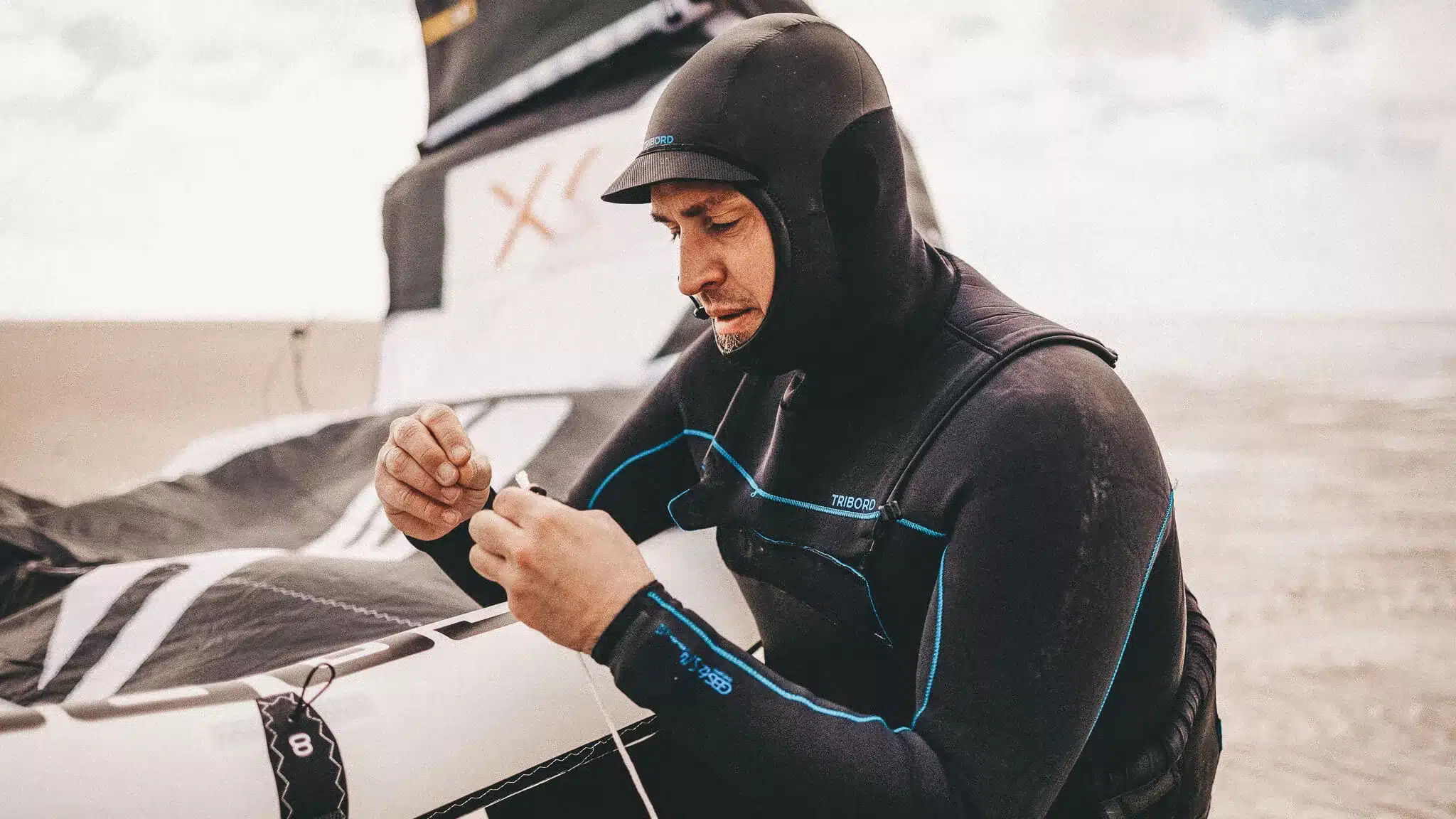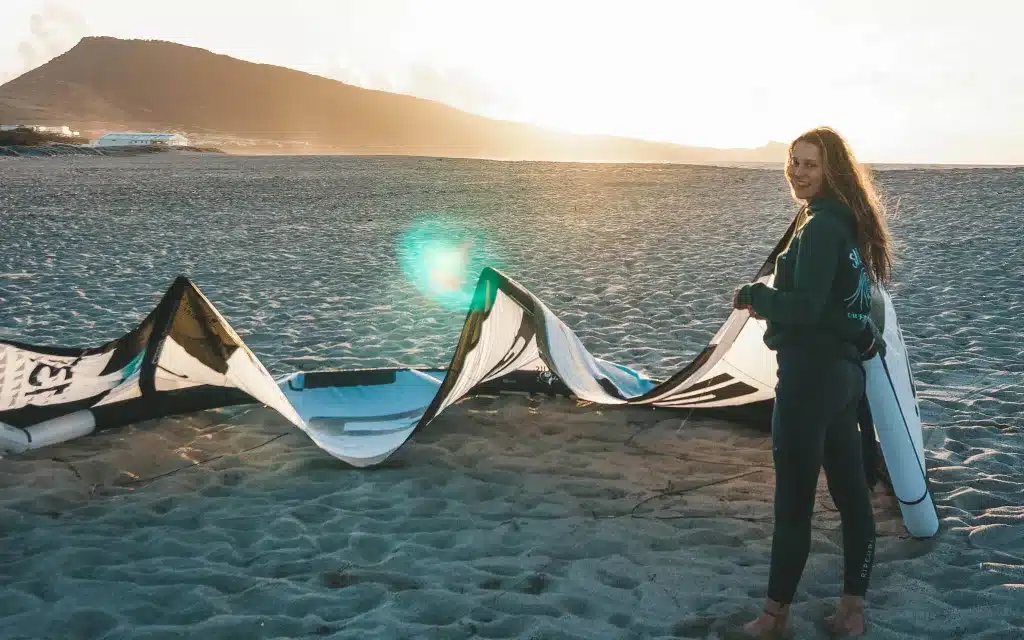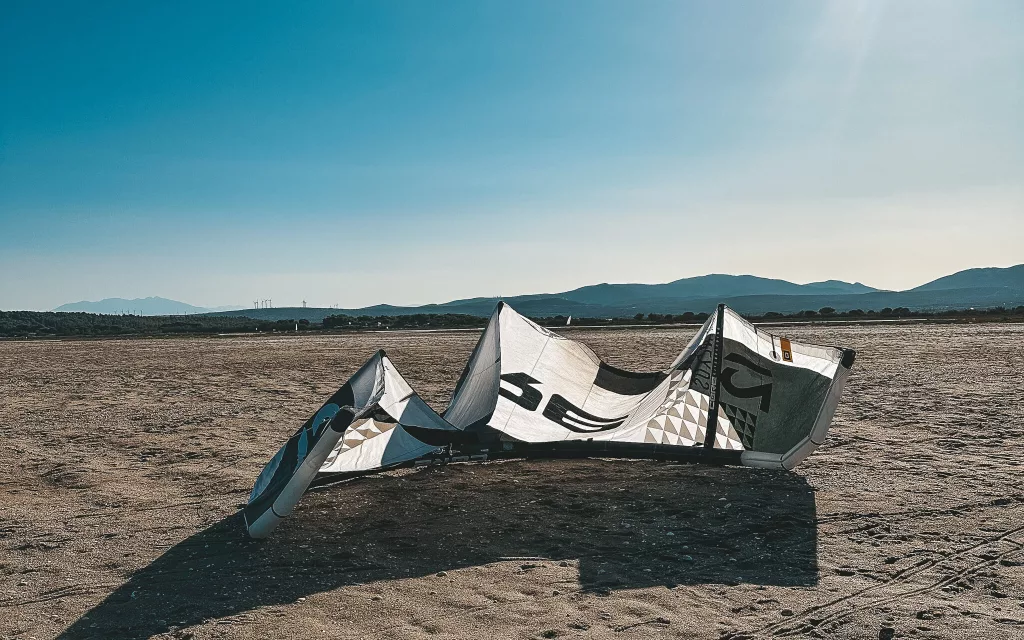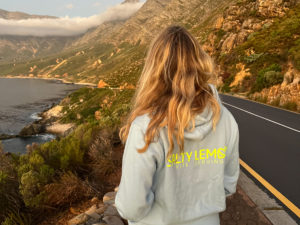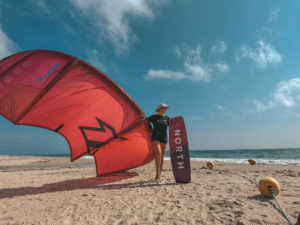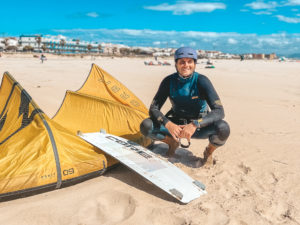You ask, we provide:
Phil Janke and Frank Ilfrich have taken the time to answer all the questions you keep asking us about. We are thrilled to present you with an exclusive interview with two insiders from Core Kiteboarding.
Phil Janke: Marketer at Core
Phil Janke’s journey at Core is a testament to his dedication and love for the sport. “Since the beginning of my tenure, I have been working closely with Frank,” he shares. His marketing approach is refreshing, honest, and realistic. “We don’t want to create unrealistic expectations that our products can’t meet. Instead, we strongly identify with our products and try to convey this identity externally,” Phil explains. This philosophy is not just a strategy; it fulfills his job. “This honesty in marketing, combined with passion and joy for the product, makes my work particularly fulfilling,” he adds.
Frank Ilfrich: A Design Visionary
Frank Ilfrich’s role at Core is central. As the leading kite and wing designer, he has significantly contributed to shaping the products that kitesurfer worldwide love and trust. His kitesurfing experience gives him a unique perspective on the sport’s evolution. “I’ve been in the kite scene since the beginning, as I started kiting in 1999,” says Frank, his eyes lighting up with memories of all the years in which he was able to help shape this sport.
A Look Inside Core
In the dynamic kitesurfing world, innovation is not just a buzzword but the essence of survival and success. Core, synonymous with quality and innovation in the kite surfing community, is a pioneer in this constantly evolving sport. Our detailed conversation with Phil Janke and Frank Ilfrich reveals the intricate processes and visionary ideas behind this leading brand.
Frank smiles knowingly when we ask him about the latest developments at Core to better understand the visionary process. “We naturally cannot divulge exact information regarding future products,” he begins, piquing the curiosity of all kitesurfing enthusiasts. But he quickly assures that Core is always one step ahead. “However, we closely monitor the market. The ‘King of the Air’ was recently, and there was much to see,” he reveals. The connection between Core and its team riders and the focus on consumer needs is crucial. “The art is to keep the intersection as high as possible, to bring a product to the market that satisfies the pro and the beginner,” Frank explains. This balance is crucial for the established models, which evolve continuously without radical changes, thus ensuring customer satisfaction and brand recognition.
We explore Core’s process from concept to market readiness. “As soon as a new model goes into production, we will start the development cycle for the successor,” Frank shares. This process involves many compromises. “If you want to increase the performance of a product in certain areas, something else might be left behind (for example, suitability for beginners or overall comfort),” he explains. Core’s “specification sheet” is a guideline that ensures each product fulfills its intended purpose.
Before each new development, Core not only gathers feedback from team riders but also from customers. “At Core, all employees are kitesurfer and use the equipment, which means we get direct feedback,” Frank adds. This comprehensive approach, including market surveys and tests, ensures that Core’s products meet and exceed expectations.
In the ever-evolving kitesurfing world, one must be adaptable to stay ahead. Frank Ilfrich explains how Core navigates this dynamic landscape. “Changes during the ongoing product cycle are rare and atypical,” he explains. This approach underscores the effectiveness of their extensive two-year development cycle, which allows for thorough testing and ensures that new products represent real progress. “This way, we can confidently exclude the need for future changes,” emphasizes Frank, underlining Core’s commitment to tangible progress.
We delve deeper into Core's latest products
An interesting topic is Core’s decision to use Aluula material in their XR Pro Kite despite having their own range of materials. Frank’s explanation is detailed and fascinating. “We were one of the first brands, along with Duotone, allowed to test this material, and we took our time with it,” he says. The three-year journey to integrate this unique Dyneema-based fabric into their designs was full of lessons and challenges. “Because Aluula comes with a stiffer airframe, possibly even with a smaller diameter, there’s also a changed flight behavior. The kite stands much further back in the wind window, which must be adjusted elsewhere to get the kite back in the correct position. This is quite complex, especially when you have to do it across an entire kite range,” he says. While this material is costly, it offers unique options for customers who desire better performance. Core’s commitment to its in-house materials like ExoTex remains strong, creating a balance between the need for innovation, affordability, and quality.
The conversation shifts to Core’s groundbreaking Intelligent Arc technology, particularly in their XR8 kite. Frank’s enthusiasm is evident as he explains, “The XR is a Delta Bow Shape, which has a relatively open arc, meaning a large projected area and thus more power, strength, and hang time.” The Intelligent Arc technology allows the kite to adjust its shape dynamically – more open with a larger projected area for higher jumps, and closer to a C-Shape when depowered for more agility and easier upwind riding: “(…) which leads to more hang time and butter-smooth landings,” adds Frank.
The Evolution of Kite Design: Are We Reaching a Plateau?
The critical question arises about the pace of innovation in kite design. Frank understands why it might seem like only a little is happening in the kite industry. However, he views the situation somewhat differently and not as drastic: “From a developer’s perspective, I must admit that this statement sometimes feels slightly insulting because we put so much work, passion, and energy into our products.” He points out that even if significant developments are less frequent, many more minor innovations continue to improve the performance of the materials significantly: “For example, the XR8 is more than 200 grams lighter than the XR7, despite reinforcement and without having to shortcut somewhere else! We’ve optimized and found ways to make the kite (…) more lightweight, which you definitely notice, especially in light wind.” He also adds the material Aluula, which allows for new advancements in the design process. “The challenge lies in developing kites that are both high-performing and practical. It’s not just about the kite flying but especially about meeting a requirement profile that allows it to relaunch from the water. Therefore, shapes one might design, which would bring even more performance, are impractical because they no longer meet the requirements (kite getting back out of the water).” Frank also mentions, “(…) the developments in the Big Air sector are fascinating, where 3-strut kites are now reaching the performance level of 5-struts, and double and triple loops have suddenly become a requirement for kites.”
Thus, Frank gives more profound insight into whether we have reached a ‘plateau’ in kite design. While one might speculate that the era of significant, noticeable changes is over, many more minor innovations are still taking place, making the products more user-friendly and better year by year.
Balanced Feedback: From the Pro Rider to the Average Consumer
The role of feedback in Core’s development process is crucial. “We work with a project software in which we can create groups. There, team riders can give us direct and unfiltered feedback,” explains Frank. However, this feedback must be carefully filtered and sorted to balance the different needs of professional riders and average consumers. “Even for the pro, who is under enormous pressure and has to kite in the most challenging conditions, will find it more pleasant if the kite is more accessible to fly/handle,” he adds, emphasizing the importance of comfort and easy handling.
Our conversation with Frank Ilfrich took an exciting turn as we discussed the role of Fehmarn, Core’s home base, in the development process. “Our location is a critical factor in our success,” says Frank. Fehmarn is the perfect testing ground for Core’s prototypes with its various spots and changing conditions. “(…) we have a super short prototype time and can have a new generation with us within 10-12 days. This allows us to take them to the water in Fehmarn immediately,” he explains. This rapid testing process, combined with Fehmarn’s demanding, cold winds, ensures that the kites are innovative but also durable and reliable under various conditions. “Nevertheless, we also test worldwide to ensure our kites function under all circumstances. Fehmarn is our base for the basic and fine-tuning, but the products must prove themselves worldwide,” Frank clarifies.
The Future of Kitesurfing with Core
As our conversation draws to a close, it becomes clear that Core’s journey in the kite surfing industry is as much about passion and commitment as it is about innovation and technology. Their approach to product development, deeply rooted in real-world testing and feedback, combined with a strong sense of community and customer service, sets them apart from the competition in the market. Phil Janke joins in, emphasizing the human aspect of Core’s success: “Especially from customers who get to know us personally or team riders who find their way to us, we receive feedback that personal contact has recharged their perception of Core,” he says. This accessibility and the long-term relationships with team riders, chosen not just for their performance but also for their alignment with Core’s culture, create a robust and loyal community around the brand.
This deep dive into Core’s ethos and operations reveals a company that is not just about producing high-quality kitesurfing equipment but is also deeply invested in the sport’s culture and its community. The blend of technical expertise, innovative spirit, and genuine passion for kitesurfing makes Core a unique and influential player in the industry.
Their commitment to continuous improvement, attention to customer needs, and ability to balance professional athletes’ demands with recreational users demonstrate a nuanced understanding of the sport’s ecosystem. Core’s approach to design and development, focusing on practicality, performance, and user-friendliness, reflects a deep understanding of the evolving needs of kite surfers.
As the sport of kitesurfing continues to grow and evolve, companies like Core, with their forward-thinking approach and dedication to the community, will undoubtedly play a pivotal role in shaping its future. Their journey is a testament to the power of combining passion with innovation, and their story is an inspiring example of how a deep connection with a sport and its community can lead to remarkable achievements and enduring success.
Read the Full Interview
Phil Janke: My name is Phil Janke, and I have been working at Core since 2015, responsible for marketing for ten years now. However, it’s important to me, I emphasize that marketing at Core is not a one-man show. Many people are involved, both permanent employees as well as external forces. Since the beginning of my tenure, I have been working closely with Frank, especially in developing our product campaigns. Our philosophy is to work hand in hand. We don’t want to create unrealistic expectations that our products can’t meet. Instead, we strongly identify with our products and try to convey this identity externally. That’s what makes my job so enjoyable. This honesty in marketing, combined with passion and joy for the product, makes my work particularly fulfilling.
Frank Ilfrich: I am Frank Ilfrich, and I have been with the company since 2005. Since 2007, I have primarily been responsible for kite design and, more recently, wing design.
I’ve been in the kite scene since the beginning, as I started kiting in 1999.
Salty Lemon: Could you tell us more about the current developments at Core? What are you working on today for tomorrow?
Frank Ilfrich: The standard marketing phrase here is that we naturally cannot divulge exact information regarding future products.
However, we closely monitor the market. The ‘King of the Air’ was recently, and there was much to see.
We are closely connected with the athletes, who communicate their requirements to us while monitoring consumer needs. The art is to keep the intersection as high as possible, to bring a product to the market that satisfies the pro and the beginner. Our established models have precise requirements they must meet. We strive for continuous development without radically changing the products to ensure recognition and customer satisfaction. Our two-year product cycle allows us to thoroughly test and ensure that new products represent real improvements. When the consumer gets the new product in hand, they should be able to feel the improvements clearly. Moreover, our development can be more staggered, and we are responsive within the development period.
And the fact that we remain relatively flexible is also one of our secrets. We have a direction, but we can also react quite easily in between.
Salty Lemon: What steps do you take from the idea to the market launch?
Frank Ilfrich: As soon as a new model goes into production, we will start the development cycle for the successor.
We then start with a kick-off meeting, collectively considering our options for the following models. In which direction will the sport develop, and/or should the model move in a new direction? In development itself, you often have to make compromises. If you want to increase the performance of a product in certain areas, something else can be left behind (for example, suitability for beginners or overall comfort). That’s precisely why we have a ‘specification sheet’ as a guideline for the respective product.
Before working on the new product, we always gather feedback. And we do this not only from team riders but also from customers. At Core, all employees are kitesurfer and use the equipment, which means we get direct feedback. In addition, we conduct market surveys and use many testivals to gather customer feedback. This feedback is then filtered, and we quickly get a good overview of what is expected of us.
Salty Lemon: Do you sometimes make adjustments or changes to a product within an ongoing product cycle (i.e., within two years), or is it left untouched for two years?
Frank Ilfrich: Changes during the ongoing product cycle are rare and atypical. Of course, minor adjustments, like adding a reinforcement patch, may occur, but that’s precisely why our long development cycle is optimal. We can conduct extensive tests and plan long water times for each product in the project plan. This way, we can confidently exclude the need for future changes.
Salty Lemon: For the Pro Kite, you chose Aluula material, even though Core develops its own materials. Could you explain the reasons for this?
Frank Ilfrich: We were one of the first brands, along with Duotone, allowed to test this material, and we took our time with it.
It took three years to market the first product with Aluula. It’s a unique material! Aluula is a fabric made of Dyneema, laminated or sealed on both sides with a film. This creates unique material properties, which offer new possibilities for kite and wing design but also bring challenges. We had to adapt our methods to fully exploit the advantages of Aluula. For example, we initially built our kite entirely from the material and quickly realized it wouldn’t work that way. During development, we also noticed where exactly the adjustments were needed and could work directly on them. Because Aluula comes with a stiffer airframe, possibly even with a smaller diameter, there’s also a changed flight behavior. The kite stands much further back in the wind window, which must be adjusted elsewhere to get the kite back in the correct position. This is quite complex, especially when you have to do it across an entire kite range.
Nevertheless, we will stick to our conventional materials and continue to produce them in close cooperation with fabric manufacturers and suppliers. Aluula is incredibly expensive, so we also want to offer other high-quality materials that make the sport more affordable. In addition, we want to stick to Dacron and ExoTex because it brings many advantages.
In conclusion, it can be said that, with Aluula, we can pass on more performance to our customers/a customer segment willing to pay for these advantages. It’s a material that offers entirely new possibilities, and after three years of testing and experimenting, we decided that Aluula is definitely a material we want to include in our portfolio.
Salty Lemon: The XR8 kite adjusts shape with the Intelligent Arc technology. Can you explain how that works and what advantages it brings? Is this a development we will see in most Core kites from now on?
Frank Ilfrich: The XR is a Delta Bow Shape, which has a relatively open arc, meaning a large projected area and thus more power, strength, and hang time. However, a prominent projected place could be better when depowering. Hence, the idea is that the kite should change its arc – the so-called Intelligent Arc. When powering the kite, the angle opens for more area, while it transitions more into a C-shape when depowering, becoming more controllable, even in the upper wind range.
When jumping, you feel the kite spread its wings, leading to more hang time and butter-smooth landings.
Salty Lemon: We have seen enormous developments in kite equipment over the past 20 years. Many in the industry are slowly getting the impression that there are no longer such significant developments and improvements in recent products. Is that true?
Frank Ilfrich: From a developer’s perspective, I must admit that this statement sometimes feels slightly insulting because we put so much work, passion, and energy into our products. However, one must also be honest regarding kitesurfing; indeed, the advances in kite design in recent years have been minor. However, it should be noted that new materials have brought a fresh breeze into the scene.
For example, the XR8 is more than 200 grams lighter than the XR7, despite reinforcement and without having to shortcut somewhere else! We’ve optimized and found ways to make the kite 200 grams more lightweight, which you definitely notice, especially in light wind. More significant steps are possible in wing sports, but the shapes have found themselves even here.
The challenge lies in developing kites that are both high-performing and practical. It’s not just about the kite flying but especially about meeting a requirement profile that allows it to relaunch from the water. Therefore, shapes one might design, which would bring even more performance, are impractical because they no longer meet the requirements (kite getting back out of the water).
However, the developments in the Big Air sector are fascinating, where 3-strut kites are now reaching the performance level of 5-struts, and double and triple loops have suddenly become a requirement for kites. Of course, one must be careful whether the average consumer has the same requirements as Big Air’s pros. Therefore, there’s still a lot of exciting stuff happening! But sure, an XR, which is now in its eighth generation… the development steps have naturally become smaller.
Salty Lemon: In a podcast, a pro rider mentioned that close collaboration with manufacturers is essential for product feedback. How does this collaboration work at Core? And how do you manage the different requirements from consumers to pro riders?
Frank Ilfrich: We work with a project software in which we can create groups. There, team riders can give us direct and unfiltered feedback and tell us what they would like to be different or what is generally essential to them. Our task as developers is then to filter and sort this feedback.
Such is definitely a balancing act, like with double loops… When they first started, only one or two riders managed them. Now, internally in our team, numerous people do double loops without batting an eye, which happened faster than I had foreseen. At first, you thout.. what a trick… that will never work for everyone, just because of the risk of injury… but now it’s become a part of normal kiting. This shows us that the products must be able to perform these standards. The important thing is that it’s easy and safe, and that’s also a challenge at the same time.
Salty Lemon: Are only pro riders in your databank, or are these team riders from all skill level?
Frank Ilfrich: At this point, it should be noted that we don’t differentiate between pro riders and team riders. Everyone is part of the team, and every one is essential. Nevertheless, kiting is done at different levels; they all might want the same kite under certain circumstances. The challenge is to bring together additional requirements and feedback from consumers and pros. So, it’s about collecting this feedback. We have a concentrated, fixed test team consisting of our chief tester, me, and 2-3 others. We bring the prototypes to a certain standard, and as soon as we believe it’s ready, we get external opinions. This can even mean I hand the kite to a regular kitesurfer, who is not a team rider, so I can get their opinion immediately. The more views/feedback we collect, the more confident we can be that we are on the right track. It is essential that the kiter always has fun and feels safe. Even for the pro, who is under enormous pressure and has to kite in the most challenging conditions, will find it more pleasant if the kite is more accessible to fly/handle.
Salty Lemon: Core is firmly rooted in Germany and specifically on Fehmarn. What unique challenges does the island of Fehmarn present for testing, and how does this environment shape the development of your materials?
Frank Ilfrich: Our location is a critical factor in our success. We have access to various spots with different conditions, allowing for quick prototype testing. Nevertheless, we also test worldwide to ensure our kites function under all circumstances. Fehmarn is our base for the basic and fine-tuning, but the products must prove themselves worldwide. In addition, we have a super short prototype time and can have a new generation with us within 10-12 days. This allows us to take them to the water in Fehmarn immediately. This advantage is something other companies need to have. Thus, we can test new prototypes directly in the afternoon after receiving them and immediately request the following changes. Being stationed on Fehmarn means we can go to the water immediately after receiving a prototype, which many other companies can’t do. The prototype arrives, and we can test it in the afternoon.
This is a huge advantage. Additionally, the cold, stiff wind here is a test for the kites. If it proves itself under these conditions, it can withstand worldwide conditions.
Salty Lemon: We have seen many kite brands come and go. Yet, Core has consistently proven to be one of the market leaders (especially in Germany) and remains one of the absolute favorites. How do you manage that?
Frank Ilfrich: There are four crucial factors.
First, we are all kitesurfer. We know what it’s about; we use our products ourselves, and we really enjoy them.
Then, we focus on high quality. This includes the processing of products and their longevity. Due to the two-year cycle, we have the background that the products remain stable in value and can be used for a long time. Quality is a top priority for us.
Also, we have excellent service. In this respect, we are pretty unique. If there are ever any problems or questions, we are always approachable and will always find a solution. Thus, the service we offer to our customers is pervasive.
And finally, we have price stability precisely because we don’t jump on every trend. Instead, we take our time to carefully analyze the situation and only bring products to the market when they are genuinely market-ready.
Phil Janke: I completely agree with Frank and would like to add that our customers and team riders often emphasize how accessible and family-like our company is. Especially from customers who get to know us personally or team riders who find their way to us, we receive feedback that personal contact has recharged their perception of Core. This is because we are a relatable group of people at Core. We have known each other for a long time and don’t choose our team riders solely based on their performance but on whether they are a good personal fit for us. We value maintaining good relationships with them beyond the 24-month contract period. Whether it’s employees, team riders, or customers, we want them all to feel advised and supported. This is a factor that isn’t measured. This familial aspect is an important, albeit immeasurable, value of our brand.
Disclaimer: This interview has been translated from German and edited for clarity.
